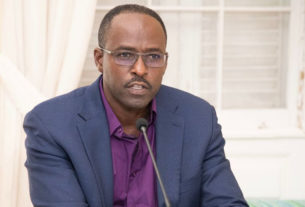BY JULIA RAWLINS-BENTHAM | FEB 28, 2022
Minister of the Environment and National Beautification, Adrian Forde, in discussion with British High Commissioner, Scott Furssedonn-Wood and UK Regional Ambassador to Latin America and the Caribbean for COP26, Fiona Clouder, during a recent courtesy call. (C. Pitt/BGIS)
The Ministry of the Environment and National Beautification must be seen as an active player in the fight against climate change.
This was underscored by Minister with responsibility for that Ministry, Adrian Forde, during a bilateral meeting with British High Commissioner, Scott Furssedonn-Wood; UK Regional Ambassador to Latin America and the Caribbean for COP26, Fiona Clouder, and other officials, at the Ministry’s Warrens, St. Michael headquarters, recently.
The Minister was joined by acting Permanent Secretaries Charley Browne, Sonia Foster, and other key technical stakeholders from the Ministry.
During the meeting, Mr. Forde outlined that Barbados was continuing its transition to renewable energy, particularly in the transportation sector, and actively seeking out ways to reduce its carbon footprint.
He also highlighted a number of initiatives being undertaken, including the Roof to Reef Programme, a tree planting project, efforts being undertaken to battle influxes of Sargassum seaweed, and plans to continue building out the blue economy.
The British High Commissioner noted that the relationship between Barbados and Britain “mattered very much”, and expressed a desire to follow up on the major issues raised during the concluded Conference of Parties (COP26) meeting.
Noting that Britain was proud to be Barbados’ partner, the High Commissioner also commended Barbados’ efforts at “stepping up to the plate” and being practical to make a difference.
He was supported by Ms. Clouder, who noted that just over 100 days had passed since the COP was held.
She outlined that from her observations, there was an urgent need by countries to act and begin the implementation process for the matters discussed.
Ms. Clouder also outlined priority issues, which she identified as mitigation, financing and adaptation. She described the area of financing as a critical issue driving adaptation, but noted that she was interested in the turquoise economy (a combination of the blue and green economies), which she believed could be the future.




